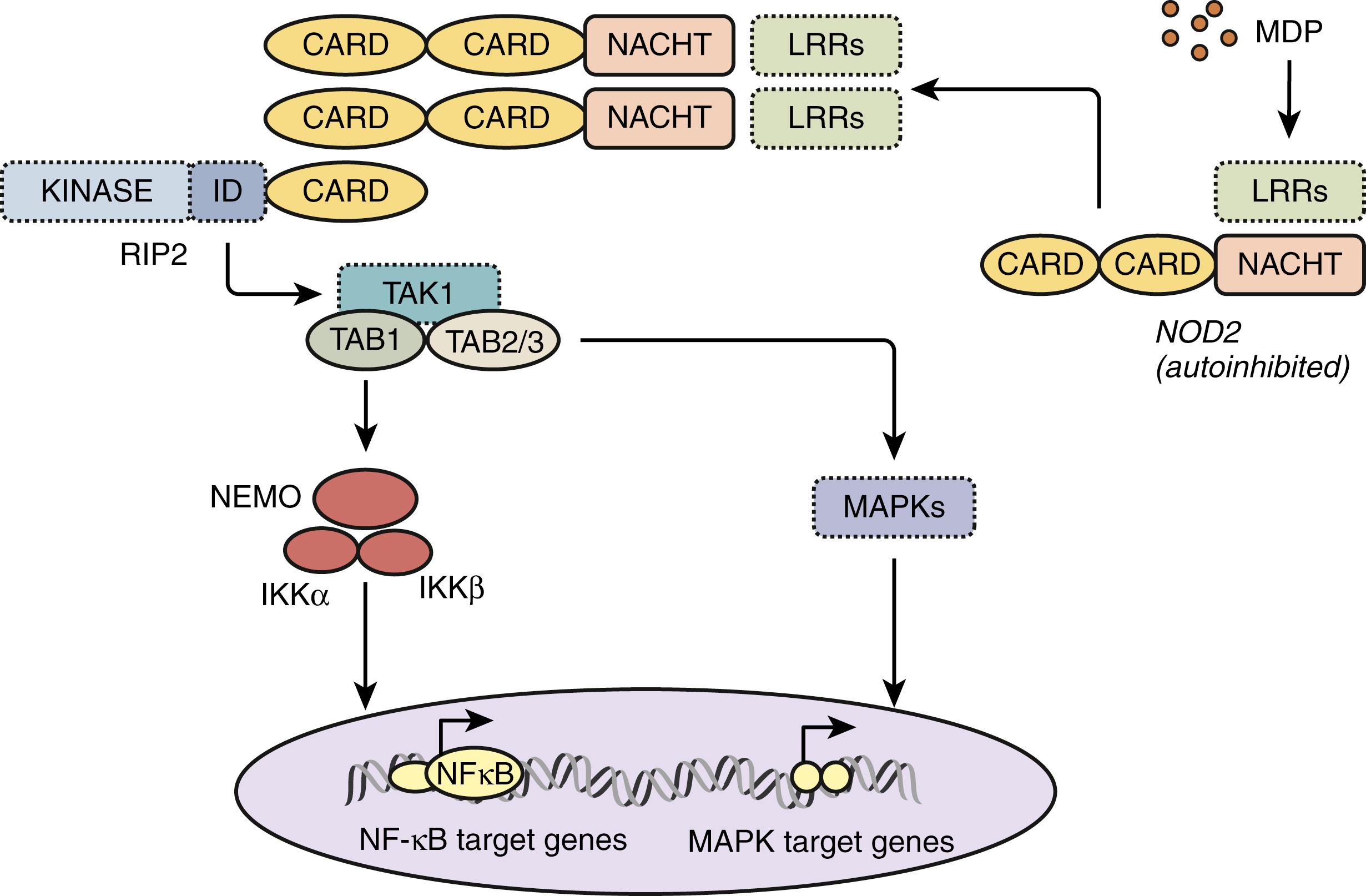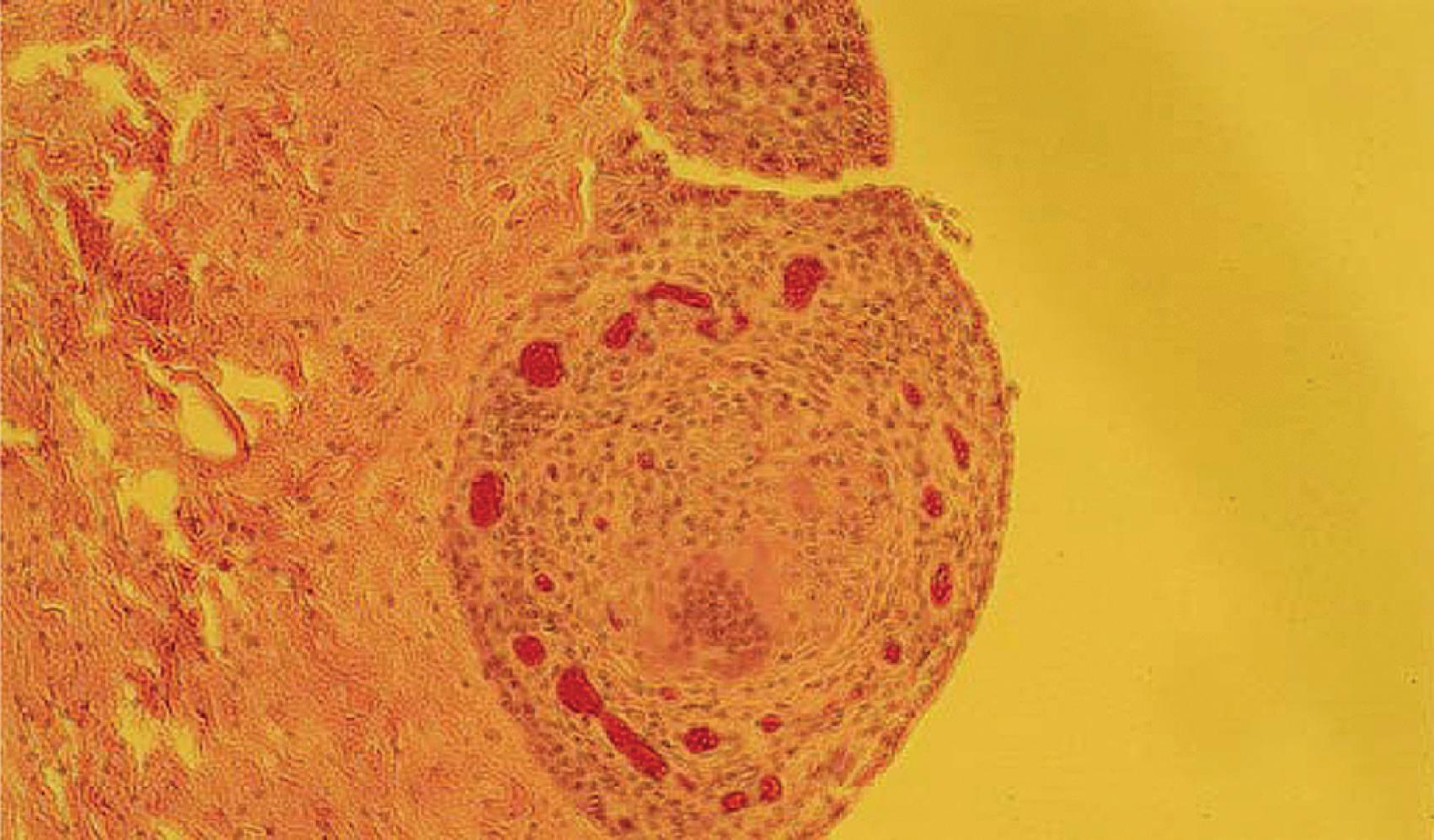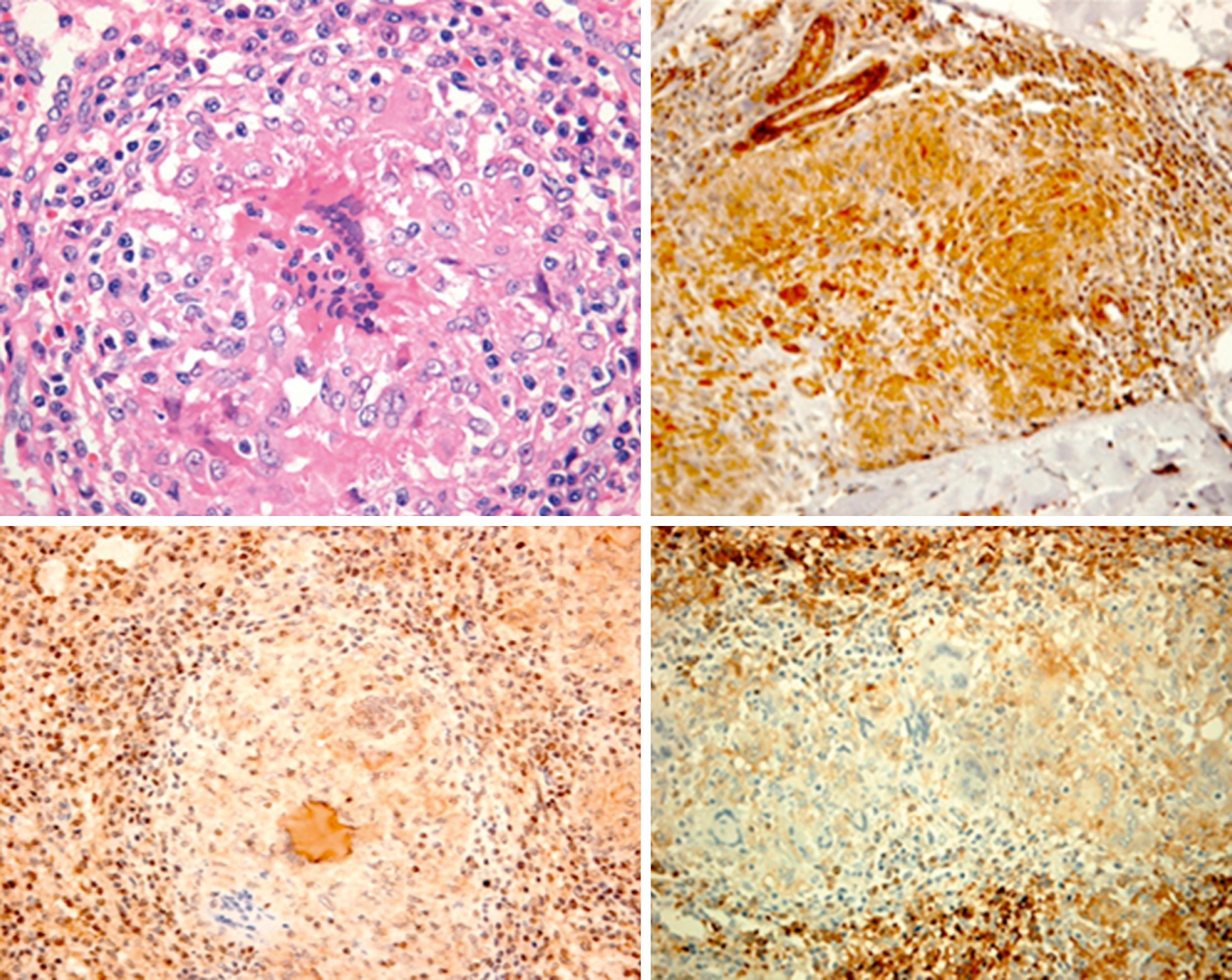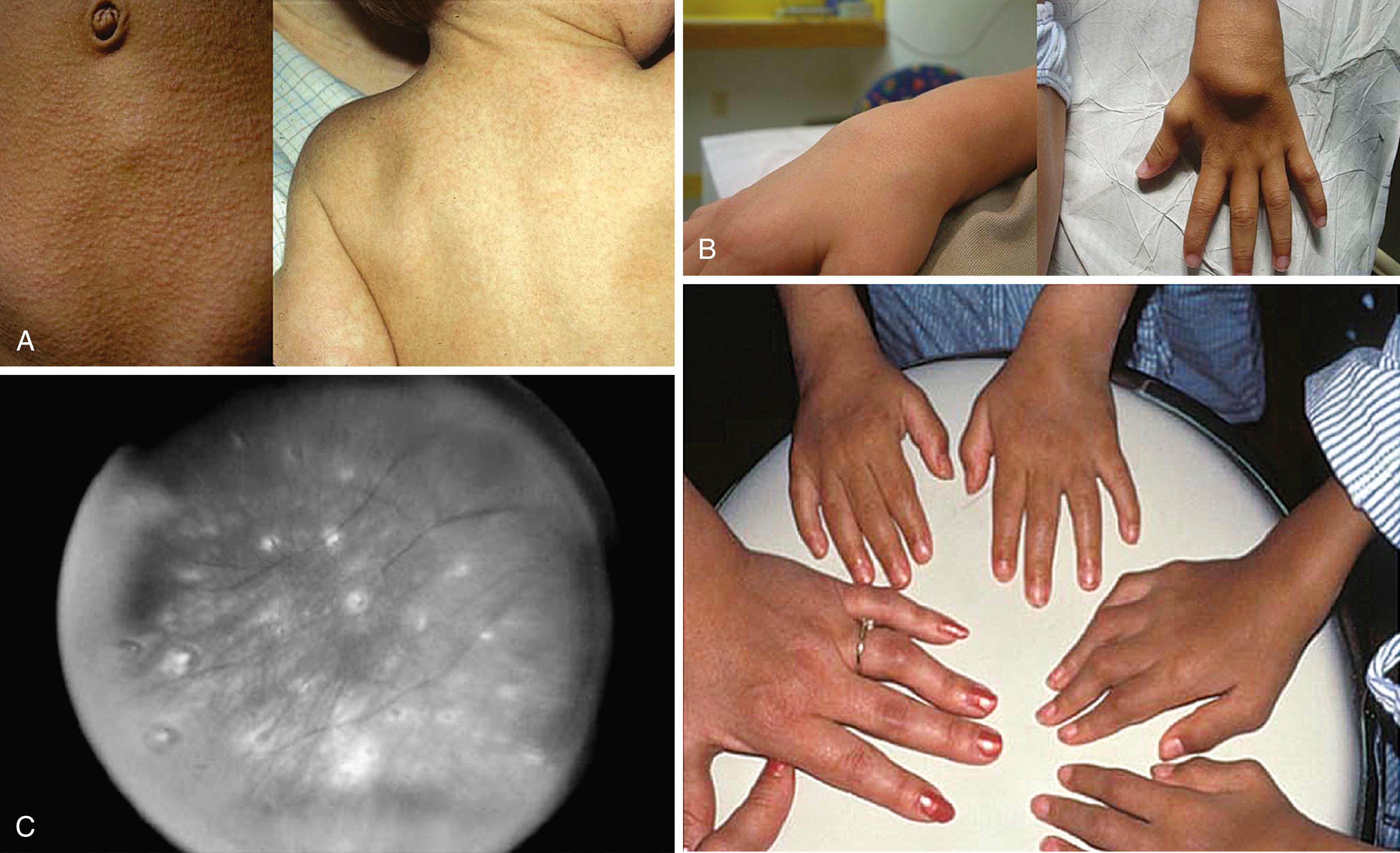Physical Address
304 North Cardinal St.
Dorchester Center, MA 02124
Pediatric sarcoidosis encompasses a spectrum of childhood granulomatous inflammatory conditions, with the hallmark being the presence of noncaseating epithelioid giant cell granulomas in a variety of tissues and organ systems. The finding in 2001 of a mutation in the nucleotide-binding oligomerization domain 2/caspase activation recruitment domain 15 (NOD2/CARD15) gene among patients with a history of familial granulomatous arthritis constituted a major advance and revealed the complexity and heterogeneity of the spectrum of pediatric sarcoidosis.
Blau syndrome (BS) and early-onset sarcoidosis (EOS) constitute the familial and sporadic forms of a pediatric disease, characterized by a triad of polyarthritis, uveitis and rash, and a unique association with mutations in or near the central NOD/NACHT domain of the NOD2 gene. The term pediatric granulomatous arthritis (PGA), proposed for both conditions, , falls short of describing the systemic and visceral manifestations that have been documented in a number of patients with PGA.
Many children with sarcoidosis are NOD2 mutation negative and tend to exhibit systemic and visceral manifestations at presentation. Within this group, the authors have identified a distinct entity, infantile-onset panniculitis with uveitis and systemic granulomatosis.
The form of sarcoidosis observed in adults, characterized mainly by interstitial pulmonary involvement and hilar adenopathy, can also be seen in the pediatric age group, though limited to older children. Certain clinical symptom complexes of granulomatous inflammation, including Löfgren and Mikulicz syndromes, can occur in children as well. Granulomatous inflammation can also be seen secondary to immunodeficiencies, in the context of malignancies and some systemic vasculitides or with certain drug therapies.
Scarce data exist on the epidemiology of pediatric sarcoidosis. A Danish National Registry study included 48 children within a cohort of 5536 patients with sarcoidosis, resulting in a calculated overall incidence for childhood sarcoidosis of 0.29 per 100,000 per year. The incidence ranged from 0.06 per 100,000 per year for children below 5 years old to 1.02 per 100,000 per year for children 14 to 15 years old. ,
An earlier international registry reported on 53 pediatric patients, of whom 14 had a family history, yielding a ratio of 1:5 for familial to sporadic forms. The International Registry of Pediatric Sarcoidosis, established in 2005, shows no gender difference or geographical predominance; the majority of patients exhibiting the classic triad of arthritis, uveitis, and rash have disease onset before reaching 5 years old.
The familial cases manifesting the classic clinical triad and an autosomal dominant transmission, also known as Blau syndrome , feature an autosomal dominant transmission pattern. Using linkage analysis of the original pedigree, the susceptibility locus for BS was mapped to a region of chromosome 16 found to contain a gene associated with Crohn disease (CD) called IBD1 . , The IBD1 gene was later found to be NOD2 . In 2001 Miceli-Richard et al. identified mutations within the central NOD/NACHT domain of the NOD2 gene in four French families with the Blau phenotype. This seminal work revealed that NOD2 substitutions associated with BS were located in a different domain of the protein than those associated with CD, which are predominantly found in the carboxyterminal leucine-rich repeats (LRRs). Wang et al. reported NOD2 mutations in 50% of 10 pedigrees with the BS phenotype. Later identical mutations were reported among patients with EOS, a sporadic disease with the same phenotype of granulomatous arthritis, uveitis, and rash described years before. Currently, BS and EOS are considered the same disease. , Over the years, an expanding number of genetic mutations of NOD2 have been published and reported within the Infevers Registry. Substitutions R334Q (arginine to glutamine in position 334) and R334W (arginine to tryptophan) are by far the most common. Using targeted deep NOD2 sequencing, genetic mosaicism, and transmission by somatic mutations have been reported as well. NOD2 mutations can be seen in patients with the complete clinical triad but also in both incomplete and expanded phenotypes. Incomplete penetrance in asymptomatic carrier status has rarely been reported. , A possible relation between particular NOD2 mutations and severity of eye involvement remains controversial. , Conversely, mutations in NOD2 are not found in variant forms of pediatric sarcoidosis displaying a more heterogeneous phenotype, nor are they generally found in adult sarcoidosis, yet certain NOD2 polymorphisms are reportedly associated with severe pulmonary sarcoidosis. ,
The NOD2 gene encodes a 1040 amino-acid protein composed of three main functional domains, namely two amino-terminal caspase recruitment domains (CARDs), a central nucleotide binding oligomerization domain (NOD/NACHT), and carboxyterminal LRRs. The NOD2 protein is a member of the family of NOD-like receptor cytosolic proteins (NLRs) involved in pathways of inflammation, apoptosis, and phagocytosis. The two amino-terminal CARDs domains of NOD2 have an important role in the mediation of nuclear factor (NF) кB activation and secretion of proinflammatory cytokines resulting from CARD–CARD interactions between NOD2 and a pivotal downstream kinase protein called receptor-interacting protein kinase 2 (RIP2). The centrally located NOD domain mediates self-oligomerization of NOD2 followed by downstream activation of effector molecules. The LRR region is structurally related to the LRR regions of the Toll-like receptors, which are pattern recognition molecules of the innate immune system, (sensing and binding molecular motifs specific to pathogens). NOD2 recognizes muramyl dipeptide (MDP), a building block of peptidoglycan of both gram-positive and gram-negative bacterial cell walls. Monocytes, granulocytes, dendritic cells, and Paneth cells in the villous crypts of the small intestine constitutively express NOD2.
NOD2, like other NLR proteins, occurs in two states: a tense, comma shaped auto-inhibited state and a relaxed NOD domain state after ligand engagement. NOD domain exposure is a prerequisite for NOD2 oligomerization and downstream pathway activation. Hydrophobic forces and salt bond interactions within the four subdomains of the NOD domain, as well as adenosine diphosphate (ADP) binding maintain the “tight” inactive state. There is evidence that engagement with the ligand could allosterically affect the NOD domain, yet the mechanism by which ligand engagement translates into a relaxed state and NOD domain exposure remains unknown. NOD2 oligomerization creates a CARD domain scaffold, allowing for interaction with a CARD-containing RIP2 kinase and downstream pathway activation ( Fig. 41.1 ).

Substitutions R334Q (arginine to glutamine in position 334) and R334W (arginine to tryptophan) are by far the most common NOD2 mutations in BS. In a recently published crystal structure of NOD2, using an 85% homolog rabbit NOD2, these mutations would disrupt a large hydrophobic area that maintains NOD subdomains in the tense autoinhibited state described earlier.
The downstream effects of NOD2 auto-activating mutations associated with BS, and their relationship with both granuloma formation and clinical phenotype, are not yet understood. Consistent with the autosomal dominant inheritance pattern, NOD2 mutations associated with BS are thought to be gain-of-function variants. Transient transfection assays performed in vitro using plasmids with powerful promoters that overexpress NOD2 have found that mutations associated with BS cause excessive NF-κB and mitogen-activated protein kinase (MAPK) activation compared with the wild-type form of NOD2 . Conversely, experiments using circulating mononuclear cells from patients with SBD could not confirm upregulation and release of interleukin-1 (IL-1) and other NF-κB-dependent cytokines, an ex vivo phenomenon seemingly contradictory with the notion of gain of function and activation of NF-κB. Furthermore, a NOD2 knock-in mouse carrying the most common R314Q mutation in BS (corresponding to R334Q in humans) showed reduced serum IL-6 and cytokine-induced neutrophil-attracting chemokine (CK) (a murine IL-8 homologue) levels in response to intraperitoneally injected MDP. R314Q knock-in mouse macrophages showed a reduction in full-length NOD2 protein levels, as well as reduced cytokine responses and activation of NF-κB and p38 MAPK in response to MDP. The same research team confirmed that human monocytes from patients with BS showed attenuated cytokine production in response to MDP. To reconcile these apparently contradictory data, one could conceive that the gain-of-function effect is not demonstrable in human peripheral blood mononuclear cells (PBMCs) because of a phenomenon of attenuation and/or unknown modulating factors. Conversely, at the tissue level, there is granulomatous inflammation with well-documented, robust proinflammatory cytokine expression (see below). Recent ex vivo experiments using BS-specific induced pluripotent stem cell lines showed that interferon (IFN)-γ acts as a priming signal through upregulation of NOD2. This effect is translated into NF-κB transnucleation and activation with proinflammatory cytokine production (supporting the significance of ligand-independent autoinflammation in the pathogenesis of BS).
Although RIP2 activation after NOD2 oligomerization in BS is well documented, one should bear in mind that there are more than 30 proteins binding NOD2 with different degrees of affinity. Several of the NOD2 binding partners directly influence or regulate its functional activity. Some interactions promote autophagy and some elicit a negative impact on NF-κB signaling, illustrating the complexity of NOD2 regulation and signaling. The role of NOD2 in autophagy is of great interest because many of the interacting proteins bind NOD2 at the cytoskeleton and cell membrane where the cell fusion machinery involved in multinucleation and granuloma formation resides. The link between NOD2 activating mutations and granuloma formation is fascinating, yet there is still a gap in our understanding of BS pathogenesis.
The pathological hallmark of sarcoidosis is the presence of noncaseating epithelioid granulomas thought to result from an exaggerated immune-inflammatory response to a persistent unidentified antigen. The granulomas consist of a central cluster of monocytes/macrophages in various stages of activation, epithelioid (morphologically reminiscent of epithelial cells), and multinucleated giant cells ( Fig. 41.2 ). A corona of mostly CD4 + T lymphocytes, scattered CD8 + T lymphocytes, and plasma cells surrounds the central region.

Blau granulomas display a distinct morphology characterized by large polycyclic granulomas with dense lymphocytic coronas. They reflect an exuberant inflammatory response, which is in line with a gain-of-function mutation in NOD2. A predominance of CD68 + macrophages and CD4 + T lymphocytes and abundant inflammatory cytokine expression in situ is typically observed. Prominent expression of IFN-γ indicates an important role for T helper (Th)1 lymphocytes in granulomatous inflammation. This is seen in association with a very high expression of IL-6, transforming growth factor (TGF)-β, and IL-17, as well as an increased expression of IL-23 receptor on granuloma cells. These findings are suggestive of activation of the Th17 lymphocyte axis in Blau granulomas.
In Blau granulomas, extensive emperipolesis (cell-in-cell phenomenon) of lymphocytes is seen within multinucleated giant cells (MGCs) and associated with MGC death, a finding of interest in view of the reported role of NOD2 in autophagy ( Fig. 41.3 ). The relationship between the formation and persistence of inflammatory granulomas and the effect of NOD2 mutations on inflammatory and apoptosis pathways remains to be established.

NOD2 mutation-associated sarcoidosis, including patients with either BS or EOS, classically presents as a clinical triad of polyarthritis, dermatitis, and uveitis ( Fig. 41.4 ). In recent years, however, because of the availability of genetic testing, a more protean clinical picture than initially observed is being reported. That this form of sarcoidosis is different from the more common adult form should not be forgotten.

The initial manifestations include the typical exanthema described below followed within months by a symmetrical polyarthritis. Ocular involvement tends to occur toward the second year. The median age at onset in the International Blau Registry was 26 months, with two unusual cases with a debut at ages 2 months and 14 years.
The rash varies in color from pale pink with varied degrees of tan to intense erythema. The lesions appear primarily on the dorsal trunk and extend to the face and limbs with accentuation of the tan color on extensor surfaces, where it may become scaly brownish over time (see Fig. 41.4A ). The lesions are tiny (5 to 7 mm), round, and barely palpable. At onset, the rash often shows a very fine desquamation, which may lead to confusion with atopic dermatitis. Over the course of years, the rash waxes and wanes. With time, the desquamation predominates, and, in adolescence, it may mimic ichthyosis vulgaris.
Subcutaneous nodules, often located on the lower limbs, are the second most common dermatological manifestation and may be clinically indistinguishable from erythema nodosum. The nodules are mildly tender and resolve without atrophy or pigmentation, even in patients with recurrent episodes. Erysipelas-like lesions have been observed as well, and in one case a urticarial rash showed typical histological features of leukocytoclastic vasculitis.
The majority of patients present with a symmetrical polyarticular or additive arthritis, affecting large and small peripheral joints and tendon sheaths. The most frequently involved joints are wrists, knees, ankles, and proximal interphalangeal (PIP) joints. A characteristic feature of both synovitis and tenosynovitis is the exuberance of the swelling. The distal flexor tendons of the digits, the extensor and peroneal tendons of the lower leg, and the flexor groups of the carpus can reach significant size. The anserine tendon sheath diameter can reach 1 cm in some cases. The synovial outpouching can acquire a cystic appearance in the dorsum of carpus and tarsus. Despite the prominent “boggy” synovitis, pain and morning stiffness are often moderate and are overall well tolerated. Except for the PIP joints, where a characteristic flexion contracture described as “camptodactyly” can be seen, the range of motion is relatively well preserved, at least in childhood (see Fig. 41.4B ). The course of the arthritis is variable, and erosive changes are mostly modest. However, limited joint mobility and joint contractures may develop with time; ulnar deviations, wrist subluxations, and joint space narrowing have been described. , It appears that, in addition to the postinflammatory sequelae on X-ray, there are a number of other abnormalities suggestive of dysplastic changes. There are limited data on the functional effects of BS arthritis over time. In a recent study, it was noted that between one-fourth and one-third of patients show moderate or severe pain and moderate to severe functional impairment after a mean follow-up of 16 years.
Become a Clinical Tree membership for Full access and enjoy Unlimited articles
If you are a member. Log in here